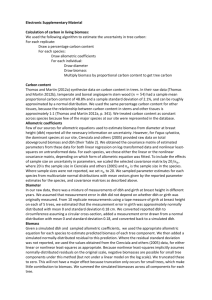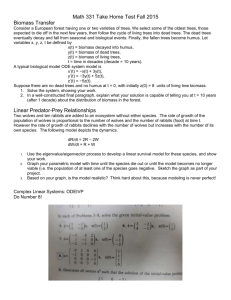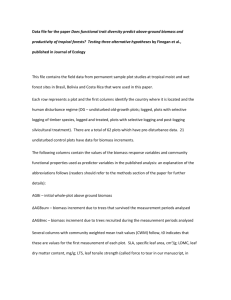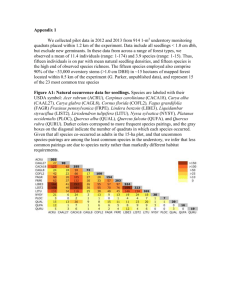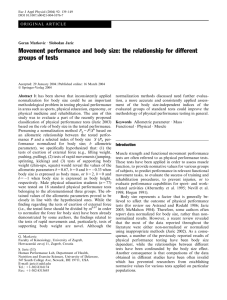Application to Vary a Methodology Determination * Avoided
advertisement
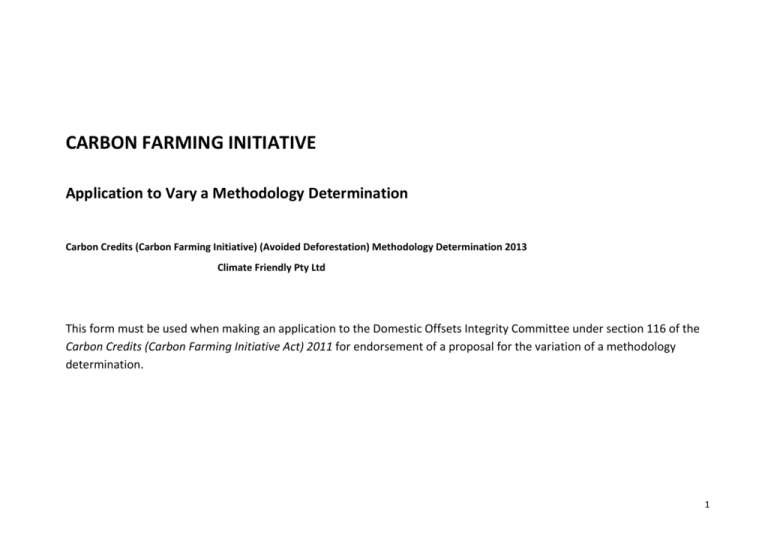
CARBON FARMING INITIATIVE Application to Vary a Methodology Determination Carbon Credits (Carbon Farming Initiative) (Avoided Deforestation) Methodology Determination 2013 Climate Friendly Pty Ltd This form must be used when making an application to the Domestic Offsets Integrity Committee under section 116 of the Carbon Credits (Carbon Farming Initiative Act) 2011 for endorsement of a proposal for the variation of a methodology determination. 1 2 Disclaimer The material in this document is made available for general information only and on the understanding that the Commonwealth is not providing advice, nor indicating a commitment to a preferred policy position. Before relying on any material contained in this document, entities should familiarise themselves with the Carbon Farming Initiative (CFI) and obtain professional advice suitable to their particular circumstances. While reasonable efforts have been made to ensure the accuracy, correctness and reliability of the material contained in this document, the Commonwealth does not accept responsibility for the accuracy or completeness of the contents or any inferences, and expressly disclaims liability for any loss, however caused and whether due to negligence or otherwise, arising directly or indirectly from the use of, inferences drawn, deductions made, or acts done in reliance on, this document or the information contained in it, by any person. Privacy As a Commonwealth agency, the Department of Climate Change and Energy Efficiency is bound by the Privacy Act 1988 (Cth). Any personal information that you submit as part of an application for assessment of a draft methodology will be collected and securely stored by the Department. Any personal information collected about you will only be used in relation to your application. Your personal information may be used by the Department for consultation purposes or to contact you in the future. For more information about the Department’s privacy practices, see the full privacy notice on the Department’s website. If you have any questions about privacy issues please contact: Privacy Contact Officer Department of Climate Change and Energy Efficiency GPO Box 854 Canberra ACT 2601 Phone: + 61 2 6159 7000 Website: www.climatechange.gov.au Intellectual Property Any entity that submits an application for endorsement of an application for variation of a methodology determination as part of the CFI warrants that they own or have a licence to use all of the relevant intellectual property rights in the application submitted. 3 Copyright in this document vests in Climate Friendly Pty Ltd. Creative Commons licence All material in this publication is licensed under a Creative Commons Attribution 3.0 Australia Licence. 4 Table of contents Instructions for applicants ...................................................................................................................... 6 Section 1: Methodology Determination Title and Applicant Details ...................................................... 9 Section 2: Expert consultation .............................................................................................................. 10 Section 3: Revised methodology determination glossary .................................................................... 10 Section 4: Justification for variation ..................................................................................................... 10 Section 5: Explanation for variation ...................................................................................................... 13 Section 6: References............................................................................................................................ 18 Section 7: Appendices ........................................................................................................................... 19 Section 8: Disclosure ............................................................................................................................. 19 Section 9: Declaration ........................................................................................................................... 20 5 Instructions for applicants This template must be used to make an application for endorsement of a proposal to vary a methodology determination under section 116 of the Carbon Credits (Carbon Farming Initiative) Act 2011 (the Act). Applicants should complete this form in accordance with Section 3.5 of the Guidelines for Submitting Methodologies. This form contains sections for applicants to provide: 1) details of the relevant methodology determination; 2) a general statement, including supporting evidence, outlining why the specified methodology determination should be varied; 3) supporting evidence to enable the Domestic Offsets Integrity Committee (DOIC) to assess whether the varied determination would comply with the offsets integrity standards prescribed in section 133 of the Act, and the requirements of the Carbon Credits (Carbon Farming Initiative) Regulations 2011 (the Regulations); 4) a copy of the methodology determination with the proposed variations clearly marked; and 5) justification, including supporting evidence, as to why each proposed variation should be made. If the application for variation is endorsed by the DOIC and subsequently approved by the Minister, it will be made into a revised methodology determination and registered on the Federal Register of Legislative Instruments. As the methodology determination is a legislative instrument, instructions must be clear, detailed and complete and all technical terms must be defined. Care must be taken to ensure the instructions are written so that there is little or no room for them to be misinterpreted. All proposed revisions must be set out in the table at Section 5 and accompanied by an explanation as to why the revision should be made, as well as supporting evidence to justify all assumptions, assertions and estimations. The inclusion of diagrams, graphics and flow charts is recommended to assist in the understanding of descriptions or statements. If an applicant wants any information to be exempt from public disclosure, the information must be clearly marked ‘CONFIDENTIAL’. An explanation of why this information should not be published during the public comment period must be provided in Section 8 of this form. Where the DOIC requires more information from an applicant on why the information should not be published, it may seek additional information from the applicant. 6 A glossary of terms specific to the proposal for a revised methodology determination must be provided in this form. The definitions of terms in the methodology glossary must be consistent with definitions in the Act. 7 Applications for variation of a methodology determination must be made to: By post: DOIC Secretariat Department of Climate Change and Energy Efficiency GPO Box 854 CANBERRA ACT 2601 Or By email to: DOIC@climatechange.gov.au 8 Section 1: Methodology Determination Title and Applicant Details Methodology determination title and applicant details Title of the Carbon Credits (Carbon Farming Initiative) (Avoided Deforestation) Methodology Determination 2013 methodology determination that is the subject of the application: Specified date on which the methodology determination was made: 23 June 2013 Name of applicant: Josh Harris Company: Climate Friendly Pty Ltd Position: Carbon Farming Development Manager Telephone: 02 8115 0007 Email: Josh.harris@climatefriendly.com Address: Level, 2 14 William Street, Woolloomooloo, 2043, Sydney Postal address (if different to above): 9 Section 2: Expert consultation Please provide the names and organisations of technical experts you have consulted in the development of this application. You must have permission from the expert individual or organisation to include their names prior to submitting this template. Name Organisation Does this expert endorse all or a part of the application for variation? (refer to relevant section if applicable) Florian Reimer, Forestry Project Manager South Pole Carbon Asset Management Ltd. Yes South Pole Carbon Asset Management Ltd. Yes f.reimer@southpolecarbon.com Pablo Llopis Benito, Forestry Project Manager p.llopis@southpolecarbon.com Section 3: Revised methodology determination glossary Provide an alphabetical glossary of terms that are specific to the application for variation of a methodology determination. Note that many terms are already defined in the Act, the Regulations and the Guidelines. Please refer to these documents before defining a new term. Please add more rows if required. Term Meaning of term Section 4: Justification for variation General statement of justification 10 Outline the reasons why the methodology determination specified in Section 1 should be varied. The Native Forest Protection methodology determination dated 23 June 2013 is demanding, very broad and requires very costly field inventory work, which is undertaken at risk before a landowner receives a return on their investment. The methodology has created a market failure by driving out the majority of project developers from the avoided deforestation project class because of the high up-front costs and risks. These costs and risk do not improve the accuracy of abatement estimates. Of note, the sections on destructive sampling for development of allometric equations and biomass surveys front load a large amount of work, which is undertaken at risk. The methodology actually disincentives climate change mitigation action by land owners. The environmental integrity of the CFI can be maintained by more efficient and streamlined monitoring guidelines. Years of experience in technical development of international forest carbon projects under high-quality carbon standard like the CDM, Verified Carbon Standard (VCS), the CarbonFix Standard (CFS), the Gold Standard (GS) or the Climate, Community, & Biodiversity Standard (CCBS) give the consulted experts an assurance that the proposed variation will achieve two main goals: a) maintain and enhance the environmental integrity of Native Forest Protection Projects under the CFI b) remove disincentives and tap into a larger reservoir of market-efficient offsetting action by Australian landowners. Please provide additional information to support the statements above. Include supporting evidence and justifications for any assumptions or estimations relied upon. The proponents of the variation have indulged in a complete, hands-on effort to develop a project under the existing Native Forest Protection determination and their findings are the result of their detailed work in the field using the methodology. The recommendations for this variation application are based on a profound understanding of forest carbon accounting, statistical sampling, forest ecosystem dynamics, allometric development, prediction of forest biomass and commercial timber volume, Geographical Information Systems, and project development coordination. The Native Forest Protection methodology as it stands is not user friendly for multi-species native forest projects, demands overreaching sampling procedures whose results could be achieved much more efficiently with the same amount of assurance, and is overburdening private landowners with rigid demands equal to a nationally financed research programme on Greenhouse Gas Accounting. Many of the data demanded to be re-monitored by every project has little variation (like wood-density per tree species) and could be more efficiently established on a national / regional level and applied by landowners as default values. This proposed variation does not go so far to propose or demand such default values, but scales back a few unnecessarily rigid requirements to a level 11 still within the limits of a feasible monitoring operation financed by private landowners upfront. The proposed variations were designed with the aim of not changing the character of the methodology, but to improve it on a few technical issues whose consequences for real-world project development can be easily overlooked, but have tremendous impacts. For example, not a single equation was removed, changed or added. Abatement calculations function exactly the same way as the prior version of the determination. The proposed variation is limited to demands of on-site monitoring, which is the most costly element of a Native Forest Protection project development. 12 Section 5: Explanation for variation Please list each section, subsection and paragraph of the methodology determination that you propose to vary and each proposed variation. You must provide an explanation as to why each proposed variation should be made. Please add more rows if required. Section Subsection/ Paragraph Proposed variation Explanation Subdivision 3.4.2 Allometric equations 3.13 Allometric equations to be validated or developed Introduction text original “In relation to each tree species or group of species in the project area measured as part of the biomass survey undertaken in accordance with Subdivision 3.4.3, the project proponent must:” Demanding private landowners to develop or validate allometric equations for every species occurring on their property, even if it is not even included in the clearing consent or they do not plan to include it into the project mechanism, is by far overreaching reasonable demands. A carbon project and offset report is not an ecological research programme. This interpretation has been shared already be the Regulator and the recommendation given by the Regulator was to only develop allometric equations to cover the species included in the clearing consent and set the biomass of non-project trees to zero if a published, peer reviewed allometric equation is not available for them. Modified to: “In relation to each tree species or group of species mentioned in the clearing consent and for which abatement shall be calculated in the project area, the project proponent must:” Subdivision 3.4.2 Allometric equations Step 2— Determination of allometric domains Added requirement: “(7) For clarity, species groups of allometric equations must have the same species-dependent growth form as defined in section 1.3 Definitions. In terms of the non-project tree buffer, please see changes and justification for 3.4.3 Biomass survey 3.41 Step 2.2. Within the determination it states that “the measurement protocols for the allometric equation are known and are consistently applied” – if the practice in the development of the allometric equation is to treat forked trees as separate trees when the fork is below 1.3m, then this should also be done when applying the allometric. This is similar to where 1.3m is measured on leaning trees (vertical height vs along the stem). To improve clarity, the application of the definition of growth form is applied here where a growth form is species-dependent. 13 Subdivision 3.4.2 Allometric equations 3.18 Step 4— Determination of plot design for tree selection (2) Enough plots must be allocated to The requirement only makes sense if it is meant to be 100 trees per capture at least 100 trees per species species or species group. This addition simply clarifies the original. or species group represented by the allometric equation across the area mentioned in subsection 3.19(1). Subdivision 3.4.2 Allometric equations 3.19 Step 5— Allocation of plots for tree selection Introduced the concept of allometric survey sites: (1) When developing an allometric equation, plots for tree selection must be allocated within: (a) an allometric survey site, and (b) the spatial extent of the allometric domain as defined in section 3.16. The original methodology does not require plots for allometric tree selection to be allocated in all carbon estimation areas. The methodology requires allocation in “one or more” CEA. There is no reason to introduce requirements of un-biased geographic determination of the allometric survey sites as long as they are within the CEAs. Because allometric survey sites do not figure into the final abatement calculations and are sub-divisions of CEAs, we see no need to mention them in Division 3.2 Stratification. (2) The geographic extent of the allometric survey sites is determined by project proponents. (3) When validating an allometric equation, plots for tree selection must be allocated across the carbon estimation area or areas in which the allometric equation is to be applied. 14 (4 ) Plots are allocated for tree selection across the allometric survey sites and carbon estimation areas using a pseudo-random number generator with a known seed number. Subdivision 3.4.2 Allometric equations 3.20 Step 6— Survey and random selection of trees for destructive sampling Added requirement: Subdivision 3.4.2 Allometric equations 3.20 Step 6— Survey and random selection of trees for destructive sampling Added requirement: Subdivision 3.4.2 Allometric equations 3.22 Step 8— Destructive sampling procedure Modified requirement (3a i): Subdivision 3.22 Deleted requirement (5) & (6): Step 8— “(6) If for a species or species group the minimum number of measured trees (100) is reached, this species no longer needs to be measured in destructive sampling plots henceforth. If the proponent opts to not measure trees after 100 area reached, then plots allocated following section 3.19 must be measured in the order of the random numbers generated and not at convenience.” “(7)Trees measured in destructive sampling plots are not to be included in the biomass survey.” “(i) at least every fourth tree cut down in accordance with subsection (1) in the order of cutting; and Abundant species will appear much more frequently in many destructive sample plots and their list of 100 individual trees per species or group of species will be reached much faster than other infrequent species. Having to continue to measure and record trees of species or species group that already reached the necessary number for the list of random tree selection is an unnecessary cost that can be avoided without having an effect on abatement calculations. The original methodology did not clearly state if trees measured in destructive sample plots can be included in the estimation of biomass per CEA if the plot was established with the same properties. As destructive sample plots are altered by the destructive sampling process, it is a cleaner solution to directly prohibit their inclusion. Cutting into components, sub-sampling and dry-weighing is a very costly part of the monitoring of the project. Every forth tree per single species still guarantees dry-weight data of 4 trees, which is sufficient to establish the dry-to-wet ratio of a single species in a single project area. This requirement introduces an unnecessary large risk for the project 15 3.4.2 Allometric equations Destructive sampling procedure “ (5) The trees mentioned in subsection (3) must have been cut down within a 30 day period. (6) Subsection (5) does not apply if each tree mentioned in subsection (1) has been analysed in accordance with section 3.23. proponent. If during first verification a problem is found by the auditor with a detail of his destructive sampling procedure, it could be interpreted in a way that the destructive sampling cannot be adapted and parts added, but the entire sampling has become invalid and has to be repeated. This is an unjustifiable risk given the high costs and large complexities of the methodology. Also the methodology already has a safeguard against too high variations in wet-to-dry ratio in 3.23 Step 9— Biomass analysis, clause (4). Seasonal variations in wet-weight are therefore already hedged. Subdivision 3.4.2 Allometric equations 3.22 Step 8— Destructive sampling procedure Modified requirement (7 in original, now 5 after variation above): Subdivision 3.4.2 Allometric equations 3.25 Step 11— Validation of allometric equation Clarification added to requirement (10): 3.4.3 Biomass survey 3.41 Step 2.1 For the value NPTi in the variable explanations of equation 12, added: “If the option (a) is selected in Step 2.2, NPTi is automatically 0.” See justification below. 3.4.3 Biomass 3.41 Step 2.2 Changed requirement 2 to: The non-project tree buffer introduces unnecessary restrictions to project development and inaccuracies. First, the restrictions concern the “(5) If an allometric equation is to be developed for a group of species, each of the trees at least every second tree per species cut down in accordance with subsection (1) must be cut into component parts in accordance with subsection (4).” “…This mandates the sub-sampling of tree components for establishment of dry-weight of every second tree used for validation of an allometric equation.” Cutting into components, sub-sampling and dry-weighing is a very costly part of the monitoring of the project. Every second tree per species still guarantees the inclusion of information of all species in the species group to contribute to development of the allometric for the species group sufficiently. Otherwise the grouping of species becomes obsolete as it is much more destructive sampling work than developing an allometric equation for each species. The necessity of sub-sampling tree components of trees used for validation of an allometric equation was not clear in the methodology and quite open to interpretation. After having discussed the issue with the Regulator and received their advice that every tree used to validate an equation must be cut into component parts and measured to determine dry weight, this variation streamlines that requirement by only sub-sampling every second tree destructively sampled for validation. 16 survey 3.4.3 Biomass survey “(2) If the deforestation plan provides that a certain kind of tree in the project area must not be cleared, the project proponent must select either or both options: fact that a project proponent could not choose to exclude a tree species from allometric development and biomass survey in the first monitoring period and include it in later reporting periods, as the non-project tree buffer is only calculated once in the first monitoring period. Second, it introduces also the confusion that biomass would have to be calculated (a) either the biomass for all trees for species not intended to be cleared, thus mandating development of allometric equations for them. Third, the non-project tree buffer seems not to be cleared in the deforestation plan is to be an anomaly in the wider frame of international forest carbon automatically set to 0 or accounting methodologies and introduce unnecessary inaccuracy. The experts drafting this methodology variation have never come across something comparable in CDM, VCS, CarbonFix or Gold Standard. The (b) the following formula must be non-project tree buffer seems to be contradictory to the section 1.3.3 of used to compute the constant, non project tree the CFI Sampling Guidelines where it is explicitly stated “ Errors buffer for each carbon estimation area using associated with inappropriate multiplication or division of two or more data collected in the first reporting period:... component estimates must be minimised.” The application of an average (3) If project proponents includes option (a) deduction to all plots’ biomass in form of the non-project tree buffer then the kinds of trees for which the biomass applies a ratio calculated as a mean from non-project biomass to all has been set to zero must not be included in the plots. From these plots, effectively a new average of biomass per plot is results of any biomass survey. calculated as part of equation 12. Thus, a ratio is applied to results later to be averaged to a ratio again. The fact that the average biomass per This does not include project trees which have plots is not an explicit variable but implicit in equation 12 does not been excluded from the results biomass survey change this fact. As the project proponent has to record in their biomass due to a lack of allometric equation according survey the fact that a tree is a non-project tree, it is actually easier, to Section 3.25 step 11.1. Such trees can be leaner and more accurate to directly set the biomass of such trees to later included if an allometric equation is zero and not apply a ratio deduction over the board to all plots. validated in accordance with Section 3.25. Parameters measured in biomass survey for project trees must also be measured for non-project trees. This includes trees clearable in the clearing consent, but have their biomass set to 0 because no allometric equation had been developed at the time of the previous offset reports. 3.41 Step 2.3 Changed the requirement (5) in original, now (6=: “If under step 2.2 option (b) is selected the total biomass of non-project trees in each plot See justification 3.41 Step 2.2. 17 must be calculated using the following formula: Please provide any additional information to support the explanations provided above. Include supporting evidence and justifications for any assumptions or estimations relied upon. In order to increase readability, all explanations and scientific references have been given directly with each item of proposed variation. Therefore statements made above are not repeated in this field. Section 6: References Provide a full citation for all reports, papers and journal articles cited in this application. [1] CDM (2011): A/R Methodological Tool - Demonstrating appropriateness of allometric equations for estimation of aboveground tree biomass in A/R CDM project activities” (Version 01.0.0). Online: https://cdm.unfccc.int/methodologies/ARmethodologies/tools/ar-am-tool-17-v1.pdf - ACTIVE MODULE [2] Pearson, T.; Walker, S. & S. Brown (2005): Sourcebook for Land Use, Land-Use Change and Forestry Projects. BioCarbon Fund & Winrock International. Online: http://www.forestcarbonportal.com/resource/sourcebook-land-use-land-use-change-and-forestry-projects [3] Verified Carbon Standard (2013): Methodology for Avoided Deforestation VM0009 v2.1. Online: http://v-c-s.org/methodologies/VM0009 - ACTIVE MODULE [4] FAO (2006): Appendix 1 - List of wood densities for tree species from tropical America, Africa, and Asia. Online: http://www.fao.org/docrep/w4095e/w4095e0c.htm 18 Section 7: Appendices List below and append all relevant documentation necessary to assess this application, including cited reports, papers and journal articles that are not publically available. Applicants must attach a copy of the relevant methodology determination with the proposed variations clearly marked. All cited references are online and given with the connecting link recently accessed. Section 8: Disclosure Clearly identify documents or parts of documents included as supporting information to the submission that are marked CONFIDENTIAL and should not be published. Confidential information must not be included in any of the sections of this form. Provide a reason why the document or part of document should not be published. Acceptable justification would include that the information should not be published if it reveals, or could be capable of revealing: trade secrets; or any other matter having a commercial value that would be, or could reasonably be expected to be, destroyed or diminished if the information were disclosed. Document/part of document Reason for confidentiality 19 Section 9: Declaration This application must be signed by a duly authorised representative of the applicant. The person signing should read the following declaration and sign below. Division 137 of the Criminal Code makes it an offence for a person to give information to a Commonwealth entity if the person providing the information knows that the information is false or misleading. The maximum penalty for such an offence is imprisonment up to 12 months. By signing below, the signatory acknowledges that he or she is an authorised representative of the applicant, and that all of the information contained in this application is true and correct. The signatory also acknowledges that any of the information provided in this application may be copied, recorded, used or disclosed by the Department of Climate Change and Energy Efficiency for any purpose relevant to the CFI. Information will not be publicly disclosed by the Department where it has been identified as confidential by the applicant. Full name of the person signing as representative of the applicant Josh Harris Position Carbon Farming Development Manager Signature Date 20
